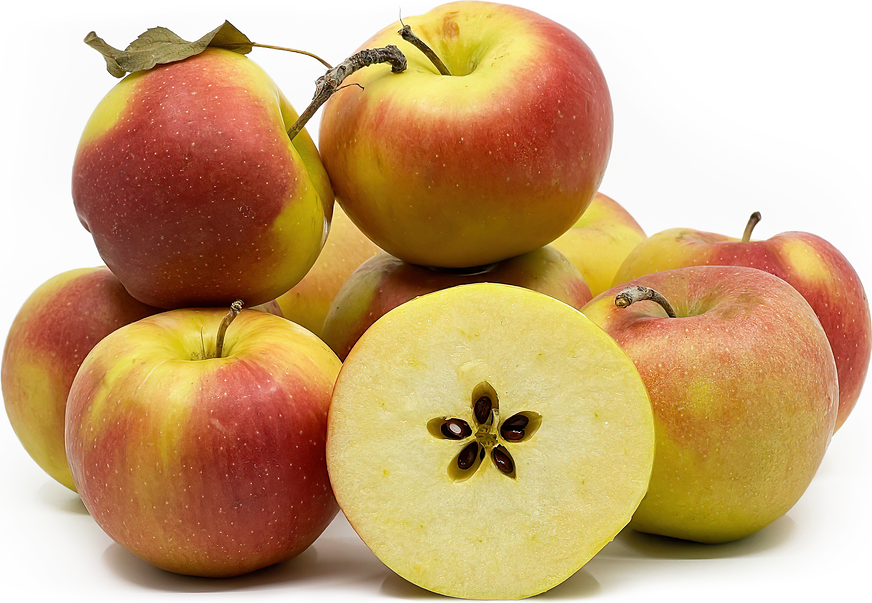


Mairac® Apple
Estimated Inventory, 1 Lb : 0
Description/Taste
Mairac® apples are a medium to large variety, averaging 7.5 to 8.5 centimeters in diameter, and have a round to conical, slightly flattened shape with a broad middle and tapered base. The apples range from 170 to 250 grams in weight and feature a thin, slender, and dark brown stem. Mairac® apples have a golden yellow-green base and are enveloped in a bright to dark red blush. The amount of blush varies depending on sun exposure during cultivation, and it can range from transparent to saturated with dark red striping. The fruit’s skin is semi-thin, smooth, and taut, covered in light colored lenticels, which gives the surface a slightly textured, rough feel. Underneath the surface, the yellow flesh is dense, aqueous, and firm with a crisp, succulent consistency. The flesh also encases a central fibrous core filled with tiny black-brown seeds. Mairac® apples are edible raw once ripe and have a balanced, rich, sweet, sour, and fruity flavor.
Seasons/Availability
Mairac® apples are available from late summer through fall, mainly between late September and early October. Once harvested, the variety can be held in controlled atmospheric storage for up to eight months.
Current Facts
Mairac® apples, botanically classified as Malus domestica, are a Swiss variety belonging to the Rosaceae family. The bi-colored cultivar was developed in the late 20th century and was chosen as a commercial cultivar for its balanced, sweet, and sour flavor. Mairac® apples are known for their disease resistance and ability to be stored for extended periods, expanding their availability in retail markets. It is important to note that Mairac® apples are a commercial brand name for the variety originally called La Flamboyante, a name given for the apple’s bright red coloring. Mairac® apples are primarily sold as fresh eating apples and are found throughout Europe and Asia as a specialty cultivar.
Nutritional Value
Mairac® apples have not been extensively studied for their nutritional properties. Bi-colored apples, in general, are a source of fiber to support digestion and minerals like potassium, magnesium, phosphorus, iron, and copper. Potassium helps the body balance fluid levels, magnesium assists in controlling nerve functions, and phosphorus supports bone and teeth health. Iron develops the protein hemoglobin for oxygen transport through the bloodstream, while copper contributes to red blood cell production. Apples also provide vitamins A, B, C, E, and K to maintain healthy organs, promote energy production, strengthen the immune system, and guard the cells against free radical damage.
Applications
Mairac® apples have a sweet-tart flavor suited for fresh and cooked preparations. The European variety is primarily consumed out of hand as a snack and is enjoyed for its crisp, juicy flesh. Mairac® apples are also sliced and served on cheese boards, chopped into salads and slaws, or cut and layered on nut butter toast. Try mixing slices into fruit medleys, using them as a fresh topping over oatmeal and grain bowls, or blending them into juices and smoothies. In addition to raw preparations, Mairac® apples are simmered into jams, jellies, and compotes or cooked into sauces to serve with roasted meats. The variety is also baked into pies, tarts, and cakes, or fried into fritters. In Switzerland, apples are popularly incorporated into apfelwahe, an open-faced pie of apples and custard, and apfel mandel kuchen, a sheet cake topped with sliced apples and almonds. Apple-based desserts are common throughout the country, including apfelbroisi, a famous dessert of apple sticks fried in butter with cinnamon and bread. While less common, Mairac® apples are sometimes roasted with other root vegetables and used in savory dishes. Mairac® apples pair well with spices like cinnamon, nutmeg, ginger, and cloves, and nuts such as pistachios, walnuts, and pine. Whole, unwashed Mairac® apples will keep for several weeks to months when stored in the refrigerator’s crisper drawer.
Ethnic/Cultural Info
Mairac® apples are among several varieties celebrated in Switzerland through Tag des Apfels, or Apple Day. Apples are one of the country's most consumed fruits, and according to the Swiss Fruit Association, the average Swiss resident consumes around 16 kilograms of apples per year, which equates to roughly one hundred apples. Tag des Apfels was established by the Swiss Fruit Federation and is annually held in the fall to celebrate and raise awareness of the fruits. Many of the apples found in Swiss commercial markets are local varieties, including Mairac®, and on Apple Day, Swiss apple producers and companies hand out free apples in public places throughout the country to promote apple consumption.
Geography/History
Mairac® apples are native to Switzerland and were created at the Fougères Arboriculture Center in Conthey, a branch of the Changins Federal Plant Production Research Station in Valais. The variety was developed in 1986 through a cross between Maigold and Gala apples, and the research team was led by Charly Rapillard. Reports note that Gala and Maigold trees were covered in protective veils to ensure that the trees were exclusively pollinated by each other in the crosses. It took over fifteen years of cultivation to pollinate, grow, and evaluate potential seedlings before one seedling was selected and named La Flamboyante in 2002. For several years, the new apple cultivar was only grown and marketed in Switzerland and Slovenia. The variety was later rebranded under the name Mairac® for commercial markets and was debuted at the international trade show Interpoma in Bolzano, Italy, in 2008. Today, Mairac® apples are managed by VariCom, a company formed from an international collaboration between French, Italian, German, and Swiss fruit growers. The variety is sold as a specialty apple throughout Europe and is also exported from Europe to markets in Central Asia. The Mairac® apples featured in the photograph above were sourced through a fresh market in Almaty, Kazakhstan.




